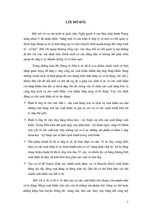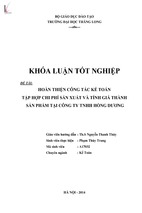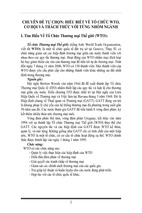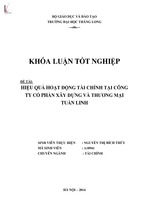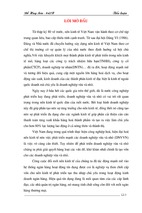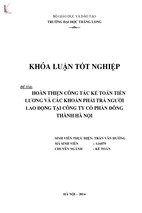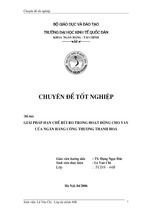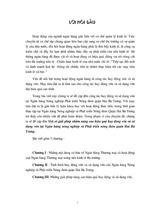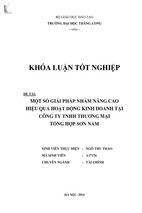FOREIGN TRADE UNIVERSITY
FACULTY OF BANKING AND FINANCE
GRADUATION THESIS
Major: Banking and International Finance
PROPOSALS FOR DEVELOPMENT OF
VIETNAMESE BOND MARKET
Student’s Full Name: Chu Le Thuy Quyen
Student ID: 1114340049
Intake: 50 – A18 – CLC
Supervisor: Phan Tran Trung Dzung, PhD.
Hanoi, May 2015
Acknowledgement
This graduation thesis is the result of thirteen weeks of research and writing
during the spring of 2015. It has been an interesting and learning experience. In
fulfilling this thesis, I would like to give my special thanks to many people for their
significant help, contribution, and recommendations during my writing process.
First and foremost, special mentions and grate thanks must go to Mr. Phan Tran
Trung Dzung, my supervisor at Hanoi Foreign Trade University. With his master
knowledge and experience in writing thesis, he has wholeheartedly helped me in
writing this thesis. I could not have been able to complete this thesis without his
positive suggestions and guidance.
Secondly, I would also like to give my heartfelt thanks to the authors who
provided me with valuable books for my thesis.
My appreciation is to my family and my friends for their supports and
encouragements.
Gratefulness is to the readers also, whose feedback will help much in improving
the thesis.
Hanoi, May 2015
Chu Le Thuy Quyen
Contents
Abbreviation
Content of Tables and Graphs
Preface
Introduction
CHAPTER 1: OVERVIEW OF BOND AND BOND MARKET...............................................4
1.1.
Overview of bonds........................................................................................................4
1.1.1.
Definition and characteristics of bond...................................................................4
1.1.2.
Types of bonds.......................................................................................................5
1.1.3.
Sources of profit from bonds.................................................................................7
1.1.4.
Factors affecting the price of a bond.....................................................................8
1.1.5.
Risks in investing bonds........................................................................................9
1.2.
Overview of bond market............................................................................................11
1.2.1.
Definition of bond market....................................................................................11
1.2.2.
Roles of bond market...........................................................................................13
1.2.3.
Types of bond trading..........................................................................................15
1.3.
Factors affecting to bond market................................................................................17
1.3.1.
Political and economic stability...........................................................................17
1.3.2.
Legal environment...............................................................................................17
1.3.3.
Participation of objectives...................................................................................18
1.4.
Credit rating................................................................................................................18
1.4.1.
Definition of credit rating....................................................................................18
1.4.2.
Function of credit rating......................................................................................18
1.4.3.
The importance of credit rating agencies.............................................................19
CHAPTER 2: OPERATION OF VIETNAMESE BOND MARKET.......................................22
2.1.
Formation and development of Vietnamese bond market..........................................22
2.1.1.
Legal framework for the development process of Vietnamese bond market......22
2.1.2.
The process of Vietnamese bond market’s formation and development.............24
2.2.
Operation of Vietnamese bond market........................................................................25
2.2.1.
Situation of bond issuance...................................................................................25
2.2.2.
Bond trading status..............................................................................................37
2.3.
Assessing operational status of Vietnamese bond market..........................................39
2.3.1.
General comments...............................................................................................39
2.3.2.
Achievements......................................................................................................41
2.3.3.
Limitations...........................................................................................................44
2.4.
Limitations’ cause.......................................................................................................46
2.4.1.
Small market size, low liquidity..........................................................................46
2.4.2.
Liquidity of the bond market...............................................................................47
2.4.3.
The lack of market makers..................................................................................48
2.4.4.
The lack of specified credit rating agencies........................................................50
2.4.5.
Awareness of corporation and investors about bonds are limited.......................52
2.4.6.
The competitiveness of bonds is low...................................................................54
2.4.7.
The legal system is not appropriate.....................................................................54
Chapter 3: PROPOSALS FOR DEVELOPMENT OF VIETNAMESE BOND MARKET.....56
3.1.
Vietnamese bond market’s prospect in the future.......................................................56
3.1.1.
period
Opportunities and challenges for the development of bond markets in the coming
.............................................................................................................................56
3.1.2.
The views and orientation Vietnamese Bond Market Government.....................58
3.2.
Lessons learned from the development of bond markets in some countries..............59
3.3.
Proposals for developing Vietnamese bond market....................................................62
3.3.1.
Stabilizing macroeconomic environment, encourage saving and investment.....62
3.3.2.
Diversifying bonds, raising market liquidity.......................................................62
3.3.3.
Establishing market makers to facilitate operation of the bond market..............65
3.3.4.
Contributing and developing system in Vietnam credit rating............................67
3.3.5.
Raising the awareness of businesses and investors on the bond market.............69
3.3.6.
Completing the legal system related to the operation of the bond market..........70
Conclusion.................................................................................................................................72
References
Abbreviations
MOF: Ministry of Finance
VGB: Vietnamese Government Bond
ADB: Asian Development Bank
CIC: Credit Information Center
OTC: Decentralized market (Over the Counter)
Content of Tables and Graphs
Tables
Table 2.1: Size of Government bonds from 2006 to 2014............................................26
Table 2.2: Interest rate of Vietnamese government bond from 2013 to Q1/2015........29
Table 2.2: Value of corporate bond issuance in recent years........................................35
Table 2.3: Size and Composition of Local Bond Markets............................................37
Graphs
Graph 2.1: Trading volume and Successful biding rate................................................28
Graph 2.2: Growth rate of Asian Countries...................................................................34
Graph 2.3: Trading and Listed value of bonds 2005-2008...........................................38
Preface
A developed securities market consists of the following assets: stocks, bonds,
and treasury certificate and derivative products. However, looking back at the
Vietnamese securities market at the moment, it has yet to achieve a high level or in
other words is not the internationally recognized as a developed securities market. The
causes of this issue include many factors such as the size of the market or the market
capitalization, the legal framework, the liquidity of the market ... However; the size of
goods traded bonds in the total size of the market is one of the most important factors.
In total daily trading volume on the official or unofficial market the stock items are a
big attraction for investors, while the trading of commodity bonds are still silent and
seems to be rather strange concept for most investors, especially domestic investors.
Meanwhile, for foreign investors and banking institutions, the commodity bonds are
indispensable items in the portfolio even commodities investment strategy for
improving fertility rates interest rate risk as well as the list of these units, and they have
also achieved some good results.
Vietnamese securities market was born this way more than nine years, while the
Vietnamese bond market is only beginning to develop more than three years and is
promising as an attractive market for investors and financial institutions. Study, learn
some basic content of bonds, actual formation, operation and development of the bond
markets of some countries in the world to compare with reference to the situation in
Vietnam stock market Men to be given a number of measures to promote and develop
the bond market in Vietnam, which is now the main goal to choose and studies on the
subject. In this project the author neglected to mention the formula calculation or
valuation of the bonds that have focused on analyzing the current situation and
development formed so that gives some solution for markets.
Due to the limited time and knowledge of the writer, this thesis inevitably
contains some limitations and shortcomings. Therefore, I would like to receive every
feedback or comment from instructor, teachers and all people who are interested in this
topic to improve the quality of this thesis.
1
Introduction
Rationale
Bonds are a useful tool to help governments, local governments and enterprises
to mobilize capital for development investment. At the same time, bonds are also a tool
on securities market helps investors get profit and limit risk. The presence of bond
markets has varied over the financial markets, overcome some of the limitations of the
market and facilitate the transfer of capital, enhancing social savings. Because of the
important role of the bond market that the countries with economies in developed
markets and countries with developing economies are interested in this market.
At present, Vietnam has a lot of bonds are issued such as government bonds,
local government bonds, corporate bonds with different purpose and maturities.
According to the Ministry of Finance, the bond market last time there was a
remarkable development, system specific mechanisms and policies for bond market
performance so far has been enacted relatively complete, covering most of the issuance
and trading of bonds, created the foundation necessary to encourage, promote and
diversify the forms of long-term capital mobilization through issuing bonds. In terms
of market operators, in 2014, the bond market was more volatile. Government bond
yields continued to be operated flexibly, closely followed developments of the market
reality, meeting the requirements of capital market development, gradually coordinated
with the operator of the central bank monetary policy and as a basis for the
mobilization of capital in the current period. In terms of the number of bonds issued are
also constantly increasing. However, Vietnamese bond market also exhibited many
limitations. According to statistics, the majority of bonds AseanBondOnline in
Vietnam's government bonds, only some are allowed to issue corporate bonds, such as
Vietnam Electricity Group, financial company shares oil and gas, investment and
development companies freeway ... the aim is to invest long-term projects. On the
other hand our country's stock market has mainly occurred stock transactions, bond
transactions are limited, mostly to buy and hold to maturity.
To improve the efficiency of raising capital, in order to perform the tasks of
economic development - social, integration needs the world economy, the development
of Vietnam bond market became a mobilization channel capital quickly, efficiently,
addressing the demand for capital investment projects, the budget deficit of the
government, needs capital for the production and reproduction of the business
expansion as well as create additional industrial goods to market demands faced by the
government and the enterprises.
2
According to the above reasons I chose research topics:
“PROPOSALS FOR DEVELOPMENT OF VIETNAMESE BOND MARKET”
Purposes for study
First: To systemize fundamental issues of bonds and bond markets
Second: To evaluate the activity of our country's bond market
Third: Since the limitations exist given some suggestions to develop the bond market
in the future
Objectives and scope of the study
Objectives of the research are the issue related to the issuance and trading of
government bonds and corporate bonds of Vietnam. Besides thesis also examines the
operation of the bond market in some countries such as the USA, the East Asian
countries to compare and have better overview of our country's bond market.
About time, limited research thesis is the operation of Vietnam bond market
from 2006 to 2015.
Methodology
To resolve the purposes of the topics, I have to apply theoretical subjects:
Financial Market and Institutions, Corporate Finance, Financial Investments, Stock, ...
underlying reasoning; Besides, I use statistical methods and data aggregation methods
to assess the operational status of Vietnamese bond market; using methods comparable
to some local bond market for further evaluation of Vietnam bond market, using the
experience of other countries as a basis to propose appropriate solutions, to promote
market Vietnam bonds advocacy and development.
Structure of the thesis
The thesis consists of 72 pages, the structure as follows:
Chapter 1: Overview of bond and bond markets
Chapter 2: Operation of the Vietnam Bond Market
Chapter 3: Proposals for development of Vietnamese bond market.
3
CHAPTER 1: OVERVIEW OF BOND AND BOND MARKET
1.1. Overview of bonds
1.1.1. Definition and characteristics of bond
1.1.1.1.
Definition
A bond is a long-term debt investment in which an investor loans money to an
entity (typically corporate or governmental) which borrows the funds for a defined
period of time at a variable or fixed interest rate. The issuer of a bond is obligated to
pay interest (or coupon) payments periodically (such as annually or semiannually) and
the par value (principle) at maturity. Bonds are used by companies, municipalities,
states and sovereign governments to raise money and finance a variety of projects and
activities. Owners of bonds are debtholders, or creditors, of the issuer.
1.1.1.2.
Characteristics of bond
Bonds have a number of characteristics. All of these factors play a role in
determining the value of a bond and the extent to which it fits in your portfolio.
-
Face Value/Par Value
The face value (also known as the par value or principal) is the amount of
money a holder will get back once a bond matures. A newly issued bond usually
sells at the par value. Corporate bonds normally have a par value of $1,000, but
this amount can be much greater for government bonds.
A bond's price fluctuates throughout its life in response to a number of
variables (more on this later). When a bond trades at a price above the face value,
it is said to be selling at a premium. When a bond sells below face value, it is said
to be selling at a discount.
- Coupon (The Interest Rate)
The coupon is the amount the bondholder will receive as interest
payments. It's called a "coupon" because sometimes there are physical coupons on
the bond that you tear off and redeem for interest. However, this was more
common in the past. Nowadays, records are more likely to be kept electronically.
The coupon is expressed as a percentage of the par value. A rate that
stays as a fixed percentage of the par value like this is a fixed-rate bond. Another
possibility is an adjustable interest payment, known as a floating-rate bond.
- Maturity
The maturity date is the date in the future on which the investor's
principal will be repaid. Maturities can range from as little as one day to as long as
30 years (though terms of 100 years have been issued).
4
A bond that matures in one year is much more predictable and thus less
risky than a bond that matures in 20 years. Therefore, in general, the longer the
time to maturity, the higher the interest rate. Also, all things being equal, a longer
term bond will fluctuate more than a shorter term bond.
- Callable and convertible
Callable bond: A call feature, or call provision, is an agreement that
bond issuers make with buyers. This agreement is called an "indenture," which is
the schedule and the price of redemptions, plus the maturity dates.
Puttable bond: A bond that allows the holder to force the issuer to
repurchase the security at specified dates before maturity. The repurchase price is
set at the time of issue, and is usually par value.
Convertible bond is a bond that can be converted into a predetermined
amount of the company's equity at certain times during its life, usually at the
discretion of the bondholder. Convertibles are sometimes called "CVs."
1.1.2. Types of bonds
Government and municipal bonds: are issued by government or local
authorities due to the budget deficit or investing in infrastructures, social welfare
or public constructions. There can be other types of bonds depending on the
purpose of government or local authorities. Some typical types of bonds are:
Treasury bonds: issued by State Treasury to finance government
expenditures. These bonds are usually medium-term or long term loans (from 5
years to 30 years) and are risk-free bonds.
Municipal bonds: issued by local authorities to mobilize capital for
infrastructures and public constructions. They are long term bonds (from 10 years
to 30 years).
Corporate Bonds: issued by corporation to mobilize capital. They
include short-term, medium-term and long-term bonds. Corporate bonds are
characterized by higher yields because there is a higher risk of a company
defaulting than a government. The upside is that they can also be the most
rewarding fixed-income investments because of the risk the investor must take on.
The company's credit quality is very important: the higher the quality, the lower
the interest rate the investor receives. Some typical types of corporate bonds are:
Mortgage bonds: A bond secured by a mortgage on one or more assets.
These bonds are typically backed by real estate holdings and/or real property such
5
as equipment. In a default situation, mortgage bondholders have a claim to the
underlying property and could sell it off to compensate for the default.
Unsecured bonds: also called debentures, are not backed by equipment,
revenue, or mortgages on real estate. Instead, the issuer promises that they will be
repaid. This promise is frequently called "full faith and credit." These bonds are
normally issued by high credit-rating or huge company with good reputation.
Convertible bonds: Bond that can be exchanged for the issuing
company's other securities (common stock or ordinary shares, for example) under
certain terms and conditions. This type of bonds is quite attractive to investors.
Income bonds: A type of debt security in which only the face value of
the bond is promised to be paid to the investor, with any coupon payments being
paid only if the issuing company has enough earnings to pay for the coupon
payment. The income bond is a somewhat rare financial instrument which
generally serves a corporate purpose similar to that of preferred shares.
Coupon bonds: are the bonds that the buyers will received an amount of
money periodically. The interest rate stated on a bond when it's issued. The coupon
is typically paid semiannually.
Fixed rate bonds: Bond whose interest amount remains constant until
maturity.
Floating rate bonds: Bond whose interest amount fluctuates in step with
the market interest rates, or some other external measure. Price of floating
rate bonds remains relatively stable because neither a capital gain nor a capital
loss occurs as market interest rates go up or down.
Amortized Bonds: An amortized bond is a financial certificate that has
been reduced in value for records on accounting statements. An amortized bond is
treated as an asset, with the discount amount being amortized to interest expense
over the life of the bond. If a bond is issued at a discount - that is, offered for sale
below its par (face value) - the discount must either be treated as an expense or
amortized as an asset.
Adjustment Bonds: issued by a corporation during a restructuring phase,
an adjustment bond is given to the bondholders of an outstanding bond issue prior
6
to the restructuring. The debt obligation is consolidated and transferred from the
outstanding bond issue to the adjustment bond.
Junk Bonds: also known as a "high-yield bond" or "speculative bond," is
a bond rated "BB" or lower because of its high default risk. Junk bonds typically
offer interest rates three to four percentage points higher than safer government
issues.
Angel Bonds: are investment-grade bonds that pay a lower interest rate
because of the issuing company's high credit rating. Angel bonds are the opposite
of fallen angels, which are bonds that have been given a "junk" rating and are
therefore much more risky.
Bond with call option (callable bond): This feature give the issuer the
right, but not obligation, to redeem his issue of bonds before the bonds maturity at
predetermined price and date.
Bond with put option (puttable bond): This feature give the issuer the
right, but not obligation to sell their bond back to the issuer at the predetermined
price and date.
1.1.3. Sources of profit from bonds
Investors who buy bonds can receive profit from the three following
potential sources:
Profit from interest income: When an investor buys a bond, he is loaning
money to the issuer. The interest rate, or the coupon rate, is determined by the
general level of interest rates at the time issuing, the maturity of the bond, and the
credit rating of the issuer.
Capital gain: Many bonds are not held until maturity. Investors need
money back before their bonds mature so they sell them through a broker. When
that happens, investors might earn a capital gain or experience a capital loss
depending upon what has happened to the credit quality of the issuer.
Interest-on-interest: The interest that is earned upon the re-investment of
interest payments. Interest-on-interest is primarily used in the context of coupon
paying bonds, where all coupon payments are assumed to be re-invested at some
interest rate and held until the bond matures, or when the bond is sold. Interest-oninterest is an important consideration an investor must make when analyzing
7
potential investments, as interest-on-interest must be considered when forecasting
an investment's total cash return.
So, the real interest rate of a bond might be far different from the nominal interest
rate. To evaluate the interest exactly, we need to consider all of above potential sources
of profit.
1.1.4. Factors affecting the price of a bond
Bonds prices are affected by the factors that influence interest rate movement.
Interest rate in the market is an important factor in evaluating the bond price. In
general, when interest rates rise, bond prices fall. When interest rates fall, bond prices
rise.
Discount Rate
A bond's value is measured based on the present value of the future interest
payments the bond holder will receive. To calculate the present value, each payment is
adjusted using the discount rate. The discount rate is a measure of what the
bondholder's return would be if he invested his money in another security. In practical
terms, the discount rate generally equals the coupon rate or interest rate associated with
similar investment securities.
Inflation
In general, when inflation is on the rise, bond prices fall. When inflation is
decreasing, bond prices rise. That’s because rising inflation erodes the purchasing
power of what you’ll earn on your investment. In other words, when your bond
matures, the return you’ve earned on your investment will be worth less in today’s
dollars.
Credit ratings
Credit rating agencies assign credit ratings to bond issuers and to specific bonds.
A credit rating can provide information about an issuer’s ability to make interest
payments and repay the principal on a bond. In general, the higher the credit rating, the
more likely an issuer is to meet its payment obligations – at least in the opinion of the
rating agency. If the issuer’s credit rating goes up, the price of its bonds will rise. If the
rating goes down, it will drive their bond prices lower. With corporate bonds, the
financial performance of the company and the cash it is generating also affect to the
credit rating. Bond analysts like to know that their debtor is generating enough cash to
comfortably service the debt. If one of the ratings agencies downgrades a company's
8
creditworthiness to below investment grade (BBB), the price of the bonds is likely to
fall.
Exchange rates
Exchange rates affect bond prices because if, for instance, the pound is
struggling against other currencies, the Bank of England may feel it necessary to
increase interest rates.
Call feature or put feature
Call feature or put feature also affects the bond price. With a callable bond is
favorable for the issuer but it is unfavorable for the investors, so that this bond usually
has higher interest rate compare to the bond with the same maturity. On the contrary,
the puttable bond has lower interest rate compare to the bond with the same maturity.
Convertible feature
The bond with convertible feature will have higher price than the one without
this feature.
The demand and supply of the market
Like other kinds of goods, bonds prices are also depend on the demand and
supply of the market. When the issuer supplies more bonds than the market demand,
the bond price will decrease and vice versa.
1.1.5. Risks in investing bonds
Bonds may generate an income stream for investors and, depending on the
issues, they may also help mitigate overall portfolio risk. But keep the six major risks
of bond investing in mind before dabbling in these individual issues.
1.1.5.1.
Interest Rate Risk
Interest rates and bond prices carry an inverse relationship; as interest rates fall,
the price of bonds trading in the marketplace generally rises. Conversely, when interest
rates rise, the price of bonds tends to fall. This happens because when interest rates are
on the decline, investors try to capture or lock in the highest rates they can for as long
as they can. To do this, they will scoop up existing bonds that pay a higher interest rate
than the prevailing market rate. This increase in demand translates into an increase in
bond price. On the flip side, if the prevailing interest rate were on the rise, investors
would naturally jettison bonds that pay lower interest rates. This would force bond
prices down.
9
1.1.5.2.
Reinvestment Risk
Another danger that bond investors face is reinvestment risk, which is the risk of
having to reinvest proceeds at a lower rate than the funds were previously earning. One
of the main ways this risk presents itself is when interest rates fall over time
and callable bonds are exercised by the issuers.
The callable feature allows the issuer to redeem the bond prior to maturity. As a
result, the bondholder receives the principal payment, which is often at a slight
premium to the par value.
However, the downside to a bond call is that the investor is then left with a pile
of cash that he or she may not be able to reinvest at a comparable rate. This
reinvestment risk can have a major adverse impact on an individual's investment
returns over time.
To compensate for this risk, investors receive a higher yield on the bond than
they would on a similar bond that isn't callable. Active bond investors can attempt to
mitigate reinvestment risk in their portfolios by staggering the potential call dates of
their differing bonds. This limits the chance that many bonds will be called at once.
1.1.5.3.
Inflation Risk
When an investor buys a bond, he or she essentially commits to receiving a rate
of return, either fixed or variable, for the duration of the bond or at least as long as it is
held.
But what happens if the cost of living and inflation increase dramatically, and at
a faster rate than income investment? When that happens, investors will see
their purchasing power erode and may actually achieve a negative rate of return (again
factoring in inflation).
Put another way, suppose that an investor earns a rate of return of 3% on a bond.
If inflation grows to 4% after the bond purchase, the investor's true rate of return
(because of the decrease in purchasing power) is -1%.
1.1.5.4.
Credit/Default Risk
When an investor purchases a bond, he or she is actually purchasing a certificate
of debt. Simply put, this is borrowed money that must be repaid by the company over
time with interest. Many investors don't realize that corporate bonds aren't backed by
10
the full faith and credit of the U.S. government, but instead depend on the corporation's
ability to repay that debt.
Investors must consider the possibility of default and factor this risk into their
investment decision. As one means of analyzing the possibility of default, some
analysts and investors will determine a company's coverage ratio before initiating an
investment. They will analyze the corporation's income and cash flow statements,
determine its operating income and cash flow, and then weigh that against its debt
service expense. The theory is the greater the coverage (or operating income and cash
flow) in proportion to the debt service expenses, the safer the investment.
1.1.5.5.
Rating Downgrades
A company's ability to operate and repay its debt issues is frequently evaluated
by major ratings institutions such as Standard & Poor's or Moody's. Ratings range from
'AAA' for high credit quality investments to 'D' for bonds in default. The decisions
made and judgments passed by these agencies carry a lot of weight with investors.
If a company's credit rating is low or its ability to operate and repay is
questioned, banks and lending institutions will take notice and may charge the
company a higher interest rate for future loans. This can have an adverse impact on the
company's ability to satisfy its debts with current bondholders and will hurt existing
bondholders who might have been looking to unload their positions.
1.1.5.6.
Liquidity Risk
While there is almost always a ready market for government bonds, corporate
bonds are sometimes entirely different animals. There is a risk that an investor might
not be able to sell his or her corporate bonds quickly due to a thin market with few
buyers and sellers for the bond.
Low interest in a particular bond issue can lead to substantial price volatility and
possibly have an adverse impact on a bondholder's total return. Much like stocks that
trade in a thin market, you may be forced to take a much lower price than expected to
sell your position in the bond.
1.2.
Overview of bond market
1.2.1. Definition of bond market
Bond market is the environment in which the issuance and trading of debt
securities occurs. The bond market primarily includes government-issued securities
11
and corporate debt securities, and facilitates the transfer of capital from savers to the
issuers or organizations requiring capital for government projects, business expansions
and ongoing operations.
Most trading in the bond market occurs over-the-counter, through organized
electronic trading networks, and is composed of the primary market and the secondary
market. Although the stock market often commands more media attention, the bond
market is actually many times bigger and is vital to the ongoing operation of the public
and private sector.
Bond market participants are similar to participants in most financial markets and
are essentially either buyers (debt issuer) of funds or sellers (institution) of funds and
often both. So typical market participants include:
Institutional investors
Governments
Traders
Individuals
1.2.1.1. Primary market
Primary market, also called the new issue market, is the market for issuing new
bonds. The main players of these markets are the private and public companies that
offer bonds in order to raise money for their operations such as business expansion,
modernization and so on.
They sell their bonds to the public through an Initial Public Offering (IPO). The
bonds can be directly bought from the shareholders, which is not the case for the
secondary market. The primary market is a market for new capital that will be traded
over a longer period. Here the bonds are issued on an exchange basis.
A primary market is not inclusive of sources, from where companies can
generate external finance over a long term, such as loans provided by financial
organizations. Through these markets, companies can also go public, which means
changing private capital to public capital.
Many companies have entered the primary market to earn profit by converting
their capital, which is basically a private capital, into a public one, releasing bonds to
the public. This phenomena is known as "public issue" or "going public".
1.2.1.2. Secondary market
12
The secondary market is that part of the capital market that deals with the bonds
that are already issued in the primary market.
The investors who purchase the newly issued bonds in the primary market sell
them in the secondary market. The secondary market needs to be transparent and
highly liquid in nature as it deals with the already issued bonds. The resale value of the
bonds in the secondary market is dependent on the fluctuating interest rates.
There are two types of secondary markets:
Auction markets, such as NYSE and Amex , in which buyers compete
with each other and, at the same time, sellers compete with each other. The highest
price any buyer will pay for a security is called its bid price, and the lowest price at
which a seller will part with the same security is called its ask or offer price.
Negotiated market such as Nasdaq, in which the price of a security is
hammered out between a buyer and a seller.
1.2.2. Roles of bond market
Bond markets have long been a stable and reliable source of long term financing
for both governments and corporates in the world, serving as a mechanism for the
transformation of savings into financing for the real sector, thus constituting an
alternative source of funding to bank financing.
1.2.2.1.
To The Economy
Bond market plays an important role in the growth of a country’s economy; the
followings are some main roles of this capital market:
Firstly, bond market helps to mobilize capital and allocation resources
efficiently in the economy. Not only do domestic bond markets provide a platform
for funding of budget deficits, but also ensure access to long-term local-currency
debt that contributes to financing long-term investments and address the large and
growing infrastructure development needs. By funding these projects through the
sale of bonds, state and local governments can avoid raising income, sales or
property taxes to pay for project costs. Increased taxes can be potentially damaging
to state and local economies as they may induce residents to move to an area with
lower taxes. Higher taxes also discourage new business growth with business
owners choosing to operate in areas with lower taxes.
Secondly, it supports transmitting signals for implementation of the
monetary policy like increasing or decreasing money supply by selling or buying
13
bonds. By doing so, it attempts to increase the demand for goods and services to
avoid job losses and prevent the economy from slowing even further or decrease
upward price pressure, curb inflation and increase the value of the Dollar.
Finally, facilitating liquidity management in tune with overall short term
and long term objectives. Since the Government bonds are issued to meet the short
term and long term financial needs of the government, they are not only used as
instruments for raising debt, but have emerged as key instruments for internal debt
management, monetary management and short term liquidity management. The
returns earned on the government bonds are normally taken as the benchmark rates
of returns and are referred to as the risk free return in financial theory. So it
finances the development activities of the Government.
1.2.2.2.
To corporation
Firstly, the corporate bond market is just one sector, of the wider market
in capital. As well as sovereign and supranational borrowers, a range of
participants in the economy, from SMEs to multinational conglomerates, and
financial institutions of all sorts, compete to borrow investors’ funds to put them to
good economic use. For the corporate sector, bonds are one component in the mix
of funding methods which also includes equity capital and retained earnings, bank
loans, syndicated loans, and other forms of borrowing.
Secondly, within the corporate bond sector, particular segments play
crucial roles. International markets, together with the domestic markets, provide
the additional capacity and the international access needed to ensure that capital
flows freely to those who can use it. Domestic lending and corporate bond markets
cater for corporate issuers and investors who do not want foreign exchange risk.
But domestic markets are often not big enough for large companies and
multinationals seeking large sums for major business development projects, whose
needs can be met by the much larger pool of investors in the international
corporate bond markets. And domestic markets cannot cater for foreign currency
requirements of multinationals, who wish to match their funding currency with
that in which they incur expenditure.
Moreover, when the corporation does not want to issue stock because of
the problem in ownership, or when the corporation has project with huge potential
profit and does not want to share it with the stockholder, issuing bond is an optimal
solution. By this way, corporation will not be manipulated and limit the cost by the
predetermined interest rate.
14
Finally, it is obviously the cost of capital by issuing bonds is much
cheaper than issuing stocks because the bond’s characteristic is more stable and
less risky than stocks.
1.2.2.3.
To investor
Bond market is diversifying the financial products. Bond is also a stable
financial facility and has lower risk than stock because investors can receive fixed
amount of money during the bonds’ life. So that, bond provides investors more and
more choices to diversify their portfolios to adapt the different level of risk that
investors are willing to accept.
1.2.3. Types of bond trading
Bonds are traded in the secondary market by two basic ways – exchange and
over the counter (OTC).
1.2.3.1. Trading on an exchange
Exchanges, whether stock markets or derivatives exchanges, started as
physical places where trading took place. Some of the best known include the New
York Stock Exchange (NYSE), which was formed in 1792, and the Chicago Board
of Trade (now part of the CME Group), which has been trading futures contracts
since 1851. Today there are many stock and derivatives exchanges throughout the
developed and developing world.
But exchanges are more than physical locations. They set the institutional
rules that govern trading and information flows about that trading. They are closely
linked to the clearing facilities through which post-trade activities are completed for
securities and derivatives traded on the exchange. An exchange centralizes the
communication of bid and offer prices to all direct market participants, who can
respond by selling or buying at one of the quotes or by replying with a different
quote. Depending on the exchange, the medium of communication can be voice,
hand signal, a discrete electronic message, or computer-generated electronic
commands. When two parties reach agreement, the price at which the transaction is
executed is communicated throughout the market. The result is a level playing field
that allows any market participant to buy as low or sell as high as anyone else as
long as the trader follows exchange rules.
The advent of electronic trading has eliminated the need for exchanges to be
physical places. Indeed, many traditional trading floors are closing, and the
communication of orders and executions are being conducted entirely electronically.
The London Stock Exchange and the NASDAQ Stock Market are completely
15
- Xem thêm -




